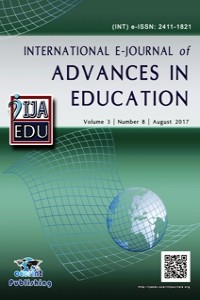Abstract
References
- Bailey, K. (2005). Practical English Language Teaching. Speaking. New York (NY): McGraw Hill. Broughton, G., Brumfit, C., Flavell, R., Hill, P., & Pincas, A. (1980). Teaching English as a Foreign Language. New York (NY): Routledge. Cruickshank, D., Jenkins, D. B., & Metcalf, K. K. The Act of Teaching. USA: McGraw-Hill College. Douglass, H. B. (2000). Principles of Language Learning and Teaching. New York (NY): Longman. Douglass Brown, H. (2000). Teaching by Principles: An Interactive Approach to Language Pedagogy. New York (NY): Longman. Guillot, M. N. (1999). Fluency and its Teaching. Great Britain: Multilingual Matters. Hedge, T. (2000). Teaching and Learning in the Language Classroom. Oxford: Oxford University Press. Krashen, S. D. (1982). Principles and Practice in Second Language Acquisition. Oxford: Pergamon. Littlewood, W. (1998). Foreign and Second Language Learning. Cambridge: Cambridge University Press. Nation, P. (1989). Improving Speaking Fluency. System, 17 (3), 377-384. http://www.victoria.ac.nz/lals/about/staff/publications/paul-nation/1989-Fluency.pdf Pollard, L. (2008). Lucy Pollard’s Guide to Teaching English. USA. Richards, J. C., & Renandya, W. A. (2002). Methodology in Language Teaching. Cambridge: Cambridge University Press. Rivers, W., & Temperley, M. S. (1978). A Practical Guide to the Teaching of English as a Second or Foreign Language. Oxford: Oxford University Press. Venkateswaran, S. (1995). Principles of Teaching English. New Delhi: VIKAS Publishing House.
Abstract
In their attempt to learn a foreign language, learners make errors. Providing
a feedback on this erroneous language output presents a multilevel dilemma.
First, teachers must decide whether or not to respond. Second, if feedback is
ever desperately required, who should do it and how should it be done? More
important, overwhelmed by the sheer number of beginner and intermediate-level
learners’ errors, keeping a record and making notes of the important errors
during interpersonal conversation such as role plays poses a serious challenge.
Equally important, teachers are more inclined to interrupt constantly the flow
of learners’ conversation to provide corrective feedback, a practice that much
dampens their enthusiasm to express themselves. In response, the current paper
addresses two main questions: which teaching technique could teachers devise to
organize their corrective feedback provision?
Which technology toolkit could be brought into classroom use to help
organize corrective feedback provision to learners’ oral flawed output? The paper
draws on the experimental use of audiovisual recordings of learners’ oral
output for the purpose of providing more adequate corrective feedback. With one
objective in mind, the experiment is aimed to test the utility of using
audiovisual recording to improve the quality of corrective feedback provision.
Audiovisual recordings provide useful database for teachers to organize any
remedial intervention and feedback provision. Moreover, the recordings will, in
the long term, constitute a corpus that could be well exploited to build an
explanatory theory for learners’ errors.
References
- Bailey, K. (2005). Practical English Language Teaching. Speaking. New York (NY): McGraw Hill. Broughton, G., Brumfit, C., Flavell, R., Hill, P., & Pincas, A. (1980). Teaching English as a Foreign Language. New York (NY): Routledge. Cruickshank, D., Jenkins, D. B., & Metcalf, K. K. The Act of Teaching. USA: McGraw-Hill College. Douglass, H. B. (2000). Principles of Language Learning and Teaching. New York (NY): Longman. Douglass Brown, H. (2000). Teaching by Principles: An Interactive Approach to Language Pedagogy. New York (NY): Longman. Guillot, M. N. (1999). Fluency and its Teaching. Great Britain: Multilingual Matters. Hedge, T. (2000). Teaching and Learning in the Language Classroom. Oxford: Oxford University Press. Krashen, S. D. (1982). Principles and Practice in Second Language Acquisition. Oxford: Pergamon. Littlewood, W. (1998). Foreign and Second Language Learning. Cambridge: Cambridge University Press. Nation, P. (1989). Improving Speaking Fluency. System, 17 (3), 377-384. http://www.victoria.ac.nz/lals/about/staff/publications/paul-nation/1989-Fluency.pdf Pollard, L. (2008). Lucy Pollard’s Guide to Teaching English. USA. Richards, J. C., & Renandya, W. A. (2002). Methodology in Language Teaching. Cambridge: Cambridge University Press. Rivers, W., & Temperley, M. S. (1978). A Practical Guide to the Teaching of English as a Second or Foreign Language. Oxford: Oxford University Press. Venkateswaran, S. (1995). Principles of Teaching English. New Delhi: VIKAS Publishing House.
Details
| Journal Section | Research Article |
|---|---|
| Authors | |
| Publication Date | August 31, 2017 |
| Submission Date | August 27, 2017 |
| Published in Issue | Year 2017 Volume: 3 Issue: 8 |
Published and Sponsored by OCERINT International © 2015 - 2025
Contact: ijaedujournal@hotmail.com
International E-Journal of Advances in Education by IJAEDU is licensed under a Creative Commons Attribution-NonCommercial 4.0 International License. Permissions beyond the scope of this license may be available at http://ijaedu.ocerintjournals.org


